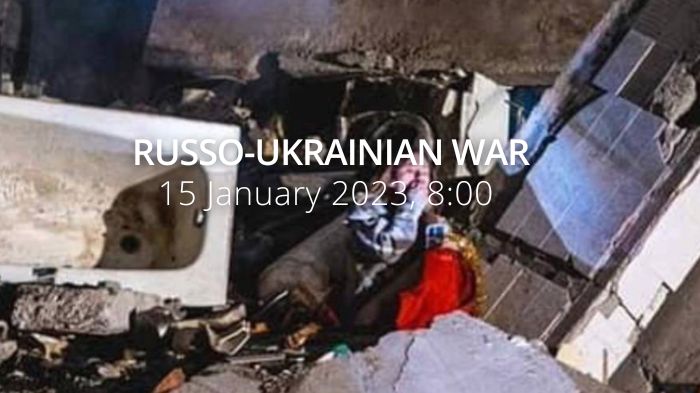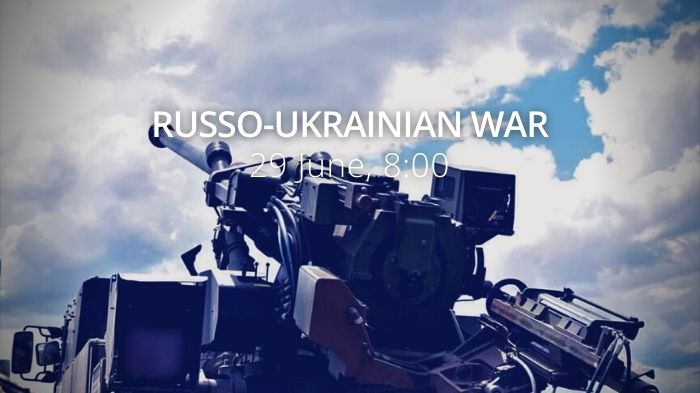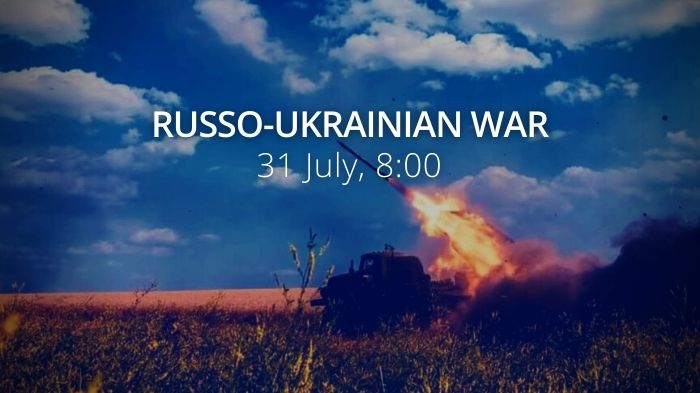Daily overview — Summary report, January 15, 2023
A close-up map of the approximate situation around the city of Bakhmut.
— War Mapper (@War_Mapper) January 15, 2023
There have been no confirmed changes to control since the last update. pic.twitter.com/7pqsS5thHS
The General Staff’s operational update regarding the Russian invasion as of 18.00 pm, January 15, 2023 is in the dropdown menu below:
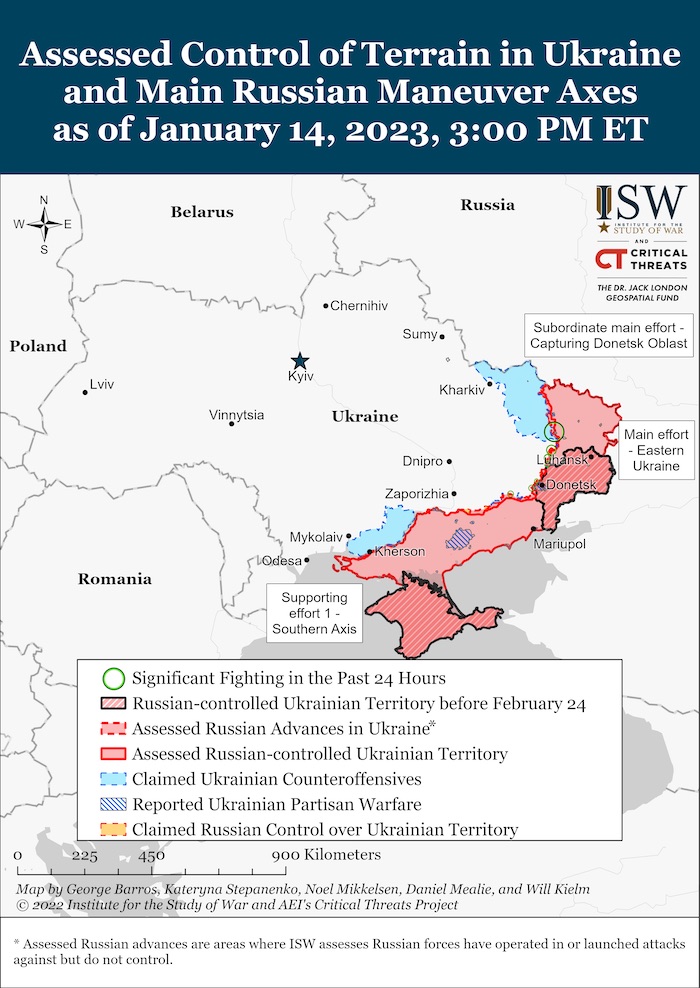
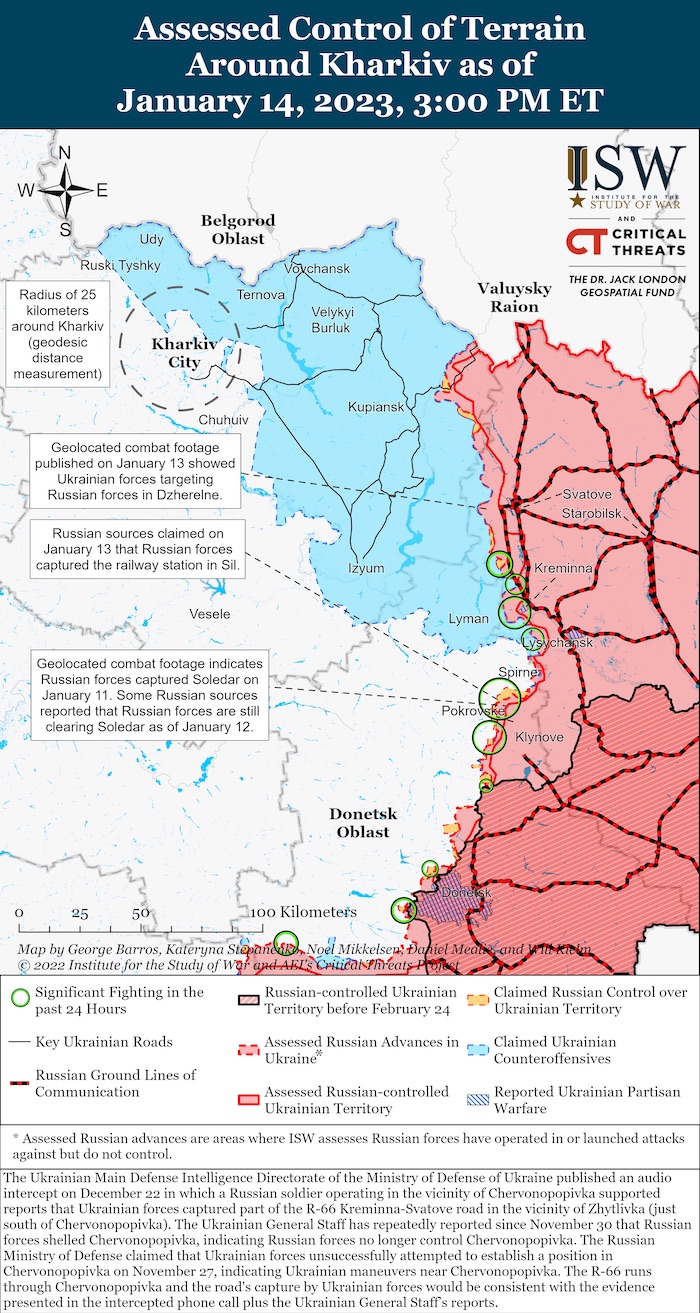
- Volyn, Polissya, Siversk and Slobozhansk axes: without significant changes, no offensive groups of Russian forces were detected. The areas of the settlements of Vovkivka and Kindrativka in the Sumy Oblast and Veterinarne, Staritsa, Ohirtseve, Gatyshche, Vovchansk, Budarki, Strelecha, Ternova, Chugunivka, Khatne and Topoli in the Kharkiv Oblast were hit by mortar and artillery fire.
- Kupiansk axis: the areas of Dvorichna, Zapadne, Sinkivka, Orlyanka, Kotlyarivka, Berestov and Krokhmalne settlements of Kharkiv Oblast, as well as Novoselivske and Stelmakhivka in Luhansk Oblast, were shelled.
- Lyman axis: Makiivka, Ploshanka, Nevske, Kreminna, Dibrova and Chervonopivka of the Luhansk Oblast came under fire.
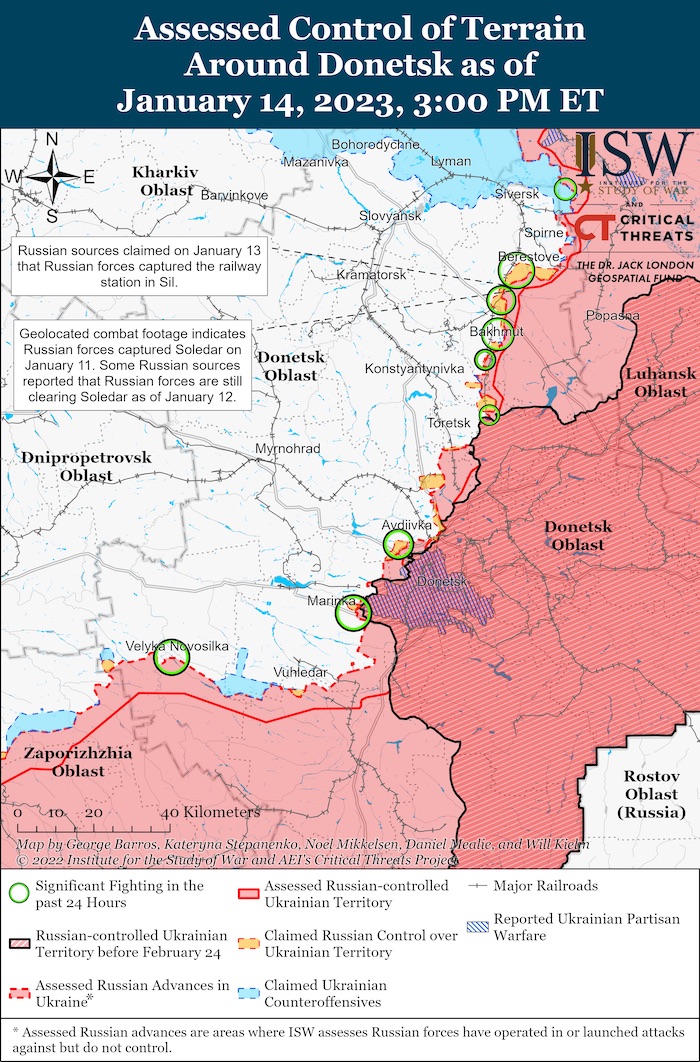
- Bakhmut axis: Spirne, Vyimka, Bilogorivka, Rozdolivka, Soledar, Paraskoviivka, Bakhmut, Vesele, Druzhba, and Severny in Donetsk Oblast were damaged by fire.
- Avdiivka axis: Russian forces fired from tanks and MLRS at the Krasnohorivka, Vesele, Avdiivka, Georgiivka, Mariinka, Berdychi, Vodyane, and Novomykhailivka settlements in the Donetsk Oblast.
- Novopavlivsk axis: Vugledar, Prechistivka, Zolota Niva and Velika Novosilka in Donetsk Oblast were shelled.
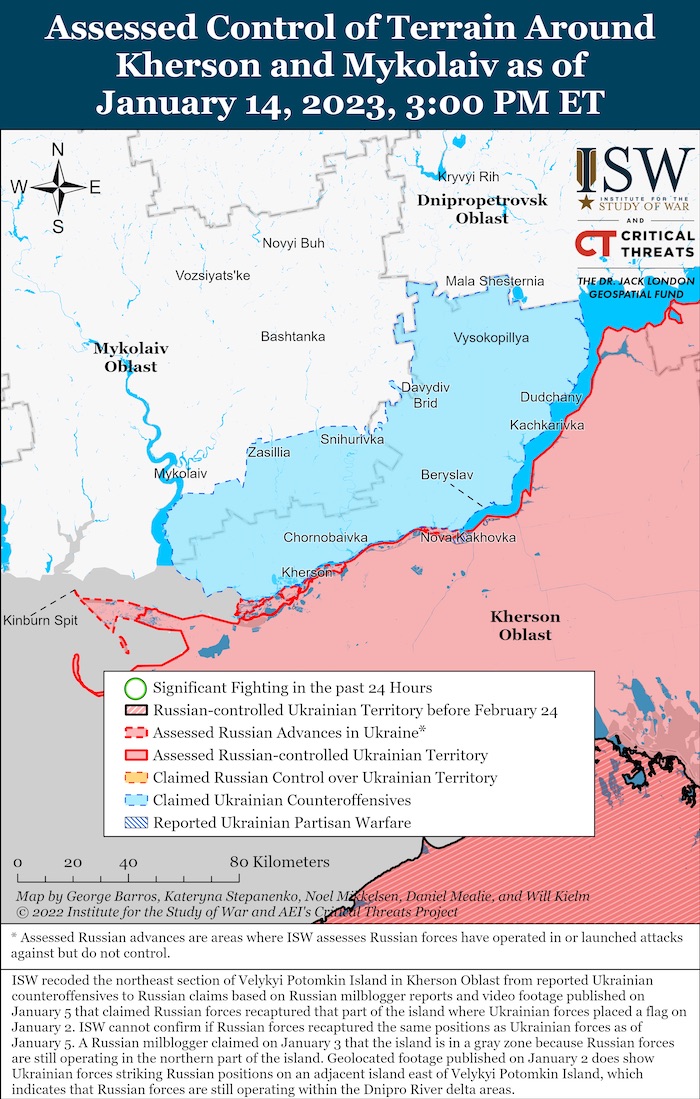
- Zaporizhzhia axis: Malynivka, Gulyaipole, Dorozhnyanka, Zaliznychne, Charivne, Biloghirya, Mala Tokmachka, Orihiv, Novoandriivka, Stepove and Plavni of the Zaporizhzhia Oblast were affected by enemy fire.
- Kherson axis: Kherson and Antonivka in the Kherson Oblast and Dmytrivka in the Mykolaiv Oblast were shelled by MLRS and artillery. There are casualties among civilians.
Military Updates
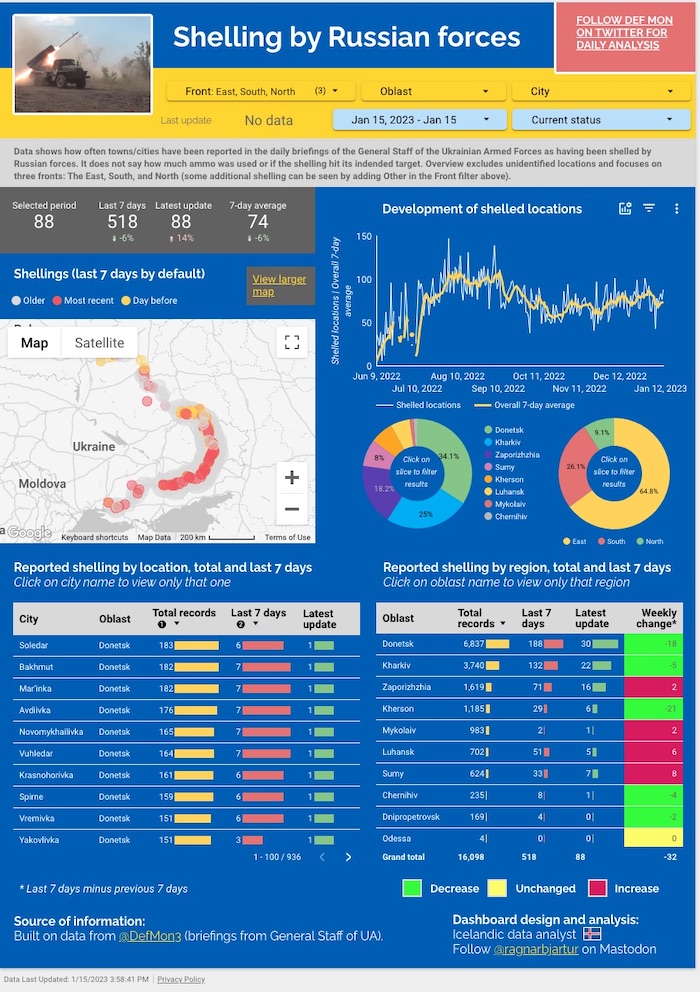
- On 12 January 2023, Andrey Kartapolov, the head of the Russian State Duma Defence Committee, suggested Russia would extend the upper age of routine military conscription from 27 to 30 in time for the Spring 2023 draft. Kartapolov said the move would be intended to enable the previously announced 30% increase in the size of Russia’s forces.
- Last year, President Putin said he supported such a move, and Russian officials are likely sounding out public reactions.
- There is a realistic possibility that Russian leaders hope a change of age criteria for routine conscription could bolster personnel available to fight in Ukraine while appear less alarming to the population than announcing another round of the unpopular ‘partial mobilisation’ process.
- On 11 January 2023, a group of at least 10 vessels of Russia’s Black Sea Fleet (BSF) departed the Novorossiysk Naval Facility.
- Given the type and number of vessels putting to sea at the same time, the activity is likely a fleet dispersal in response to a specific threat to Novorossiysk that Russia believes it has identified.
- It is unlikely that the deployment signifies preparation for unusual maritime-launched cruise-missile strikes. It is highly unlikely that the fleet is preparing for amphibious assault operations. The BSF largely remains fixed by perceived threats from Ukraine and continues to prioritise force protection over offensive or patrol operations.
Losses of the Russian army
As of Sunday 15 January, the approximate losses of weapons and military equipment of the Russian Armed Forces from the beginning of the invasion to the present day:- Personnel – about 115290 (+630),
- Tanks – 3106 (+2),
- Armoured combat vehicles – 6183 (+10),
- Artillery systems – 2094 (+4),
- Multiple rocket launchers –MLRS - 437 (+0),
- Air defence means – 219 (+0),
- Aircraft - 286 (+0),
- Helicopters - 276 (+0),
- Automotive technology and fuel tanks – 4846 (+0),
- Vessels/boats - 17 (+0),
- UAV operational and tactical level – 1872 (+5),
- Special equipment – 187 (+1),
- Mobile SRBM system – 4 (+0),
- Cruise missiles – 749 (+26)
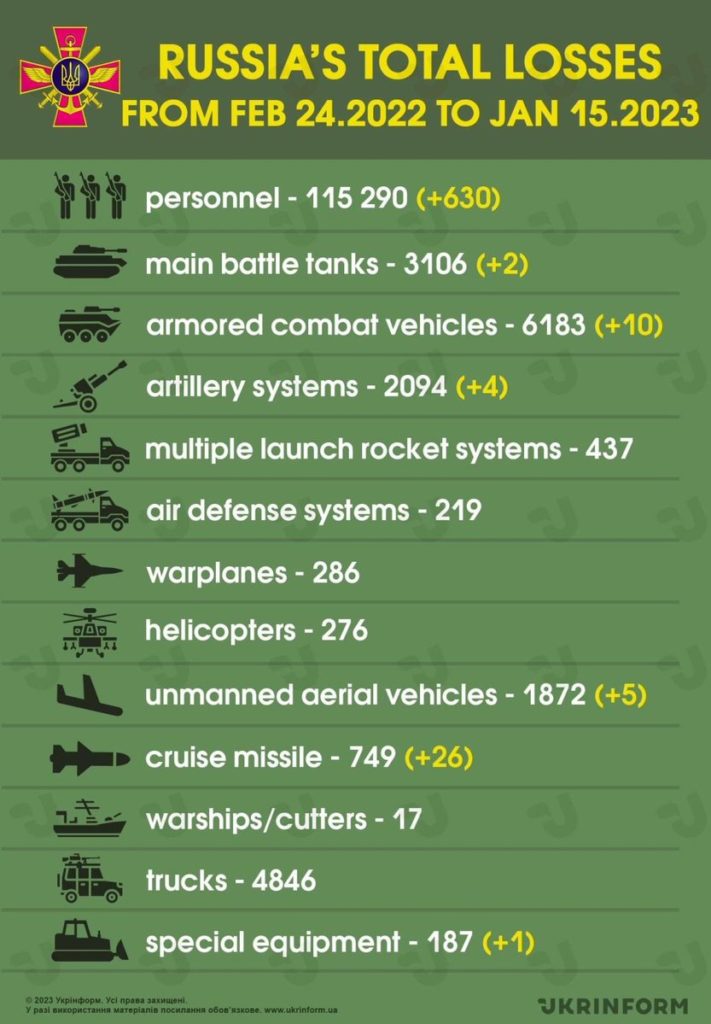
Humanitarian
https://twitter.com/EuromaidanPress/status/1614612238186283008 Russia cancels new prisoner exchange round, Ukrainian officials say, Reuters reports. “Russia cancelled at the last minute on Saturday a scheduled exchange of prisoners of war, the Ukrainian body dealing with prisoners said. Another round of exchange of prisoners was planned today with the Russian side," the Coordination Headquarters for the Treatment of Prisoners of War said on the Telegram messaging app. "However, it was cancelled at the last moment at the initiative of the Russian side." Kyiv was attacked by Russian missiles on Saturday morning. A Russian missile has hit a residential building in the village of Kopyliv in Kyiv Oblast. 18 houses were damaged in Kyiv Oblast in the morning attack. Several explosions have been reported in Ukraine’s capital, Kyiv, with local authorities reporting an attack on the capital's infrastructure. Kyiv residents have reported at least four explosions in Ukraine’s capital. At the time information about the explosions was shared, an air-raid siren had not been sounded in Kyiv or the oblast. The siren was sounded after the explosions. Russians missiles hit critical infrastructure facilities on Saturday afternoon, Ukrainska Pravda reports, citing Maksym Kozytskyi, Head of Lviv Oblast Military Administration, and Oleh Syniehubov, Head of Kharkiv Oblast Military Administration. "Russian forces have hit a critical infrastructure facility in Lviv Oblast. There are possible power outages and water supply interruptions. Stay in shelters. The threat is ongoing! Two strikes of enemy missiles on a critical infrastructure facility [in Kharkiv oblast] were recorded in the oblast. Most districts of the city of Kharkiv remain without electricity immediately after the explosion, the movement of metro trains is temporarily suspended. The Russians launched a missile attack on Ukraine. In the city of Dnipro, a residential building was hit. As of this morning, 18 people were killed by a Russian missile in their house in Dnipro. 73 people are injured – more than 40 of them are in hospitals, and four people in serious condition are in intensive care units. The rescue operation is ongoing. The fate of more than 40 people remains unknown Explosions are ringing out in the city of Kyiv and Kyiv Oblast on Saturday, air defence systems are operating. On Saturday, energy facilities were damaged as a result of the missile attack on Ukraine. Russian forces hit Kharkiv, Lviv, Ivano-Frankivsk, Zaporizhzhia, Vinnytsia and Kyiv oblasts. Kharkiv and Kyiv oblasts’ energy systems experience most difficulties after Russian attack. https://twitter.com/EuromaidanPress/status/1614328379762970626 Missile attack on Ukraine: two thermal power plants damaged, one stops producing electricity, Ukrainska Pravda reports, citing DTEK Ukrenergo, the national energy regulator. “During today's massive attack, the occupiers attacked two thermal power plants of DTEK Energo, which had already been repeatedly hit by enemy attacks. This is the 26th terrorist attack on DTEK Energo facilities.” Ukraine's energy minister says 'difficult' days lie ahead after latest Russian attacks, Reuters reports. “Ukrainian Energy Minister German Galushchenko said on Saturday that the coming days would be "difficult" on the energy front after a massive missile attack by Russia hit critical infrastructure in several regions. Due to the shelling in the majority of the regions, emergency (power) cut-offs are being introduced. The coming days will be difficult, he wrote on Facebook. Galushchenko said energy infrastructure in six Ukrainian regions was damaged after the attacks.”Environmental
https://twitter.com/EuromaidanPress/status/1614322741716434944 IAEA director general to hold talks in Kyiv, Ukrinform reports, citing a statement published on the agency’s website. “The Director General will travel to the South Ukraine and Rivne Nuclear Power Plants (NPPs) as well as to the Chornobyl site to launch the missions consisting of two IAEA experts at each of the facilities, the statement says. It is noted that the IAEA already has a permanent presence of up to four experts at Ukraine’s largest NPP, Zaporizhzhia, and a two-member team will also be stationed at the Khmelnytskyi NPP in the coming days. According to Grossi, IAEA nuclear safety and security experts will monitor the situation at the plants, assess their equipment and other needs, provide technical support and advice, and report their findings to IAEA headquarters. In total, the IAEA will have around 11-12 experts present in the country at any given time. The IAEA Director General will also meet next week senior Ukrainian government officials in the capital Kyiv on his proposal to set up a nuclear safety and security protection zone around Zaporizhzhia (ZNPP), where the IAEA has been present for more than four months. I remain determined to make the much-needed protection zone a reality as soon as possible. My consultations with Ukraine and Russia are making progress, albeit not as fast as they should. I remain hopeful that we will be able to agree and implement the zone soon, Director General Grossi said. As reported, in December, IAEA Director General Rafael Mariano Grossi held negotiations in Moscow regarding the creation of a safety zone around the occupied Zaporizhzhia NPP. On March 4, the Zaporizhzhia NPP was seized by the Russian military. Since then, the Russians have been placing military equipment and ammunition in the plant’s territory and shelling the surrounding area.”Legal
US Ambassador to OSCE: Russia has taken up to 2,000 children from Ukraine since beginning of 2023, Ukrainska Pravda reports, citing Ukrinform, quoting Michael Carpenter, US Ambassador to the OSCE, during a special meeting of the Permanent Council in Vienna. “According to the Ambassador, Russia has been abducting children from their homes and families en masse in recent weeks, moving them to Russian territory under the guise of evacuation. In addition, the US Ambassador pointed out that lists of children who should be involved in the war upon reaching the age of majority are being compiled in the occupied Donetsk and Luhansk. Children born in 2005 and 2006 are subject to mandatory military registration. Such advance planning to use Ukrainian children as cannon fodder in Russia's war is just plain evil, Carpenter said. In November 2022, President Volodymyr Zelenskyy said that according to official data alone, Russia had abducted 11,000 Ukrainian children from Ukraine.”Support
Europe gears up to send Western tanks to Ukraine, CNN reports. “The Western alliance’s response to Russia’s invasion of Ukraine received a shot in the arm this week as multiple European nations for the first time answered President Volodymyr Zelensky’s longstanding call to supply modern battle tanks to Kyiv. France, Poland and the United Kingdom have pledged to soon send tanks for the Ukrainian military to use in its efforts to protect itself from Russia. Finland is considering following suit. […] The moves have piled pressure on Germany, which last week said it would transfer infantry fighting vehicles to Kyiv but is yet to commit to sending tanks. Chancellor Olaf Scholz has insisted that any such plan would need to be fully coordinated with the whole of the Western alliance, including the United States. Western officials told CNN said that the decision by some countries but not others to send more tanks was part of a broader assessment of what was happening on the ground in Ukraine. NATO allies have spent recent weeks talking in detail about which countries are best placed to provide specific types of assistance, be it military equipment or money. One senior Western diplomat suggested that more countries could increase their levels of military support in the coming weeks as the war enters a new phase, and a fresh Russian offensive could be just around the corner as the anniversary of the invasion approaches. https://twitter.com/ZarinaZabrisky/status/1614264990713937921 But Germany’s support is seen as crucial. Thirteen European countries, including Poland and Finland, are in possession of modern German Leopard 2 tanks, which were introduced in 1979 and have been upgraded several times since, according to the European Council on Foreign Relations think tank. While any re-export of the tank by these nations would typically need approval from the German government, Berlin has suggested it would not block their transfer to Kyiv. Vice Chancellor Robert Habeck said Thursday that Berlin would not stand in the way of other countries re-exporting Leopard tanks. […] German deputy government spokeswoman Christiane Hoffmann said Friday that it had not received an official request from Poland or Finland. […] The decision of NATO members to send the tanks to Ukraine is not an uncontroversial move. German diplomats are privately briefing their concern that it marks an escalation in the West’s response to Russia and will be viewed in Moscow as a provocation. Other European officials argue that the West has already transfered plenty of other advanced weapons that have been used to kill Russians, as well as provided intelligence used extensively to the benefit of Ukraine. Notably, the US has supplied its long-range advanced HIMARS rocket systems to Ukraine, which have helped it turn the tide of the war in recent months. In light of this, the officials contend, sending additional tanks is not that significant an escalation, regardless of what Moscow might say. While European allies remain largely united in their support of Ukraine, diplomats who spoke to CNN said there was disagreement as to whether sending tanks and more weapons is the fastest and most effective way to bring the conflict to an end. It is expected that the UK and France will continue to pressure Germany into joining them in the effort in the coming days. If they succeed it would mean the three major European powers in lockstep as the war rumbles toward its one-year anniversary.”Ukraine urges Western allies to intensify military support in order to counter the upcoming Russian offensives - The Timeshttps://t.co/mg2InW2lTs
— Euromaidan Press (@EuromaidanPress) January 14, 2023
Ukraine wants to create a brigade of Leopard 2 tanks, five countries are ready to hand over these tanks – Kuleba, Mil.in.ua reports. “Ukraine plans to create a tank brigade of German-made Leopard 2 tanks. The Minister of Foreign Affairs Dmytro Kuleba said this in an interview with journalist Vadym Karpiak. According to him, five countries are now ready to hand over these tanks to the Armed Forces of Ukraine. The head of the Ministry of Foreign Affairs reminded that Poland and Finland have already agreed to transfer tanks of this type to Ukraine. According to the minister, Ukraine is objectively half a step away from solving the issue of tanks. […] The minister clarified that together with Poland and Finland, we already have five countries that are ready to transfer [tanks], but are waiting for clearing the issues with Germany. And I know at least three more countries that are ready to do it, but they are not talking about it yet, because they want to say it out loud, only if they are one hundred percent sure that the Germans will come out and say: we support it, Kuleba said. We should add that the head of the Office of the President of Poland, Paweł Szrot, stated that the international coalition in the matter of transferring tanks to Ukraine, in particular the Leopard 2 tanks, already exists, and Germany should join it. […] In turn, Polish government spokesman Piotr Müller said during a briefing in the Sejm that Warsaw is forming “the widest possible coalition” and expects Germany to join it.”Germany supplied four mine-clearing tanks to Ukraine
— Euromaidan Press (@EuromaidanPress) January 15, 2023
German govt report does't mention the exact type of the vehicles, @militarnyi_en believes those are Minenräumpanzer Keiler mine-clearing tanks based on the modified chassis of an M48 tankhttps://t.co/UYrzNmpeGe pic.twitter.com/Ru4PvLmvdq
British Prime Minister confirms transfer of Challenger 2 tanks, Ukrainska Pravda reports, citing the Office of the British Prime Minister. “British Prime Minister Rishi Sunak confirmed that his country will provide Ukraine with Challenger 2 tanks, during a telephone conversation with President Volodymyr Zelenskyy. The Prime Minister outlined the UK’s ambition to intensify our support to Ukraine, including through the provision of Challenger 2 tanks and additional artillery systems, the statement said.” UK to transfer over 12 Challenger 2 tanks to Ukraine, first 4 immediately, Ukrainska Pravda reports, citing The Sun. “The Prime Minister has been clear that the UK has to stand by its commitment to Ukraine, and that includes ensuring it has the critical equipment to defend itself and change the battlefield equation, the source notes. A group of four Challenger 2 tanks will be delivered to eastern Europe immediately, with a further eight following shortly afterwards, The Sun reports. Sunak is said to have held talks with defence and security officials this week, telling them that getting the tanks to Ukraine should be an operational priority.” UK will send AS90 self-propelled guns to Ukraine, Ukrinform reports. “A squadron of 14 tanks will go into the country in the coming weeks. Around 30 AS90s, which are large, self-propelled guns, operated by five gunners, are expected to follow, reads the press release published on the website of the Government of the United Kingdom. It is underscored that sending Challenger 2 tanks to Ukraine is the start of a gear change in the UK’s support.” A new batch of German military support: mine-clearing tanks, mobile heating systems, Ukrinform reports. “Germany handed over another batch of military support to Ukraine. As the Federal German Government reports on its website, the support includes four mine-clearing tanks, four mobile and protected mine-clearing systems, 10 border protection vehicles (in total 95 already in operation in Ukraine), and 120 mobile heating systems (previously, 48 systems were transferred). All equipment is from industrial stocks or new. The section about military support in planning includes 40 Marder infantry fighting vehicles with ammunition, a Patriot air defence system with missiles, and 100,000 first aid kits.”UK to supply 14 Challenger 2 tanks to Ukraine in "coming weeks," followed by around 30 AS90 self-propelled guns - UK PM Sunakhttps://t.co/JmoQyQhCOq pic.twitter.com/9t0zYMo95Y
— Euromaidan Press (@EuromaidanPress) January 15, 2023
New Developments
- Zelenskyy says what is needed to stop Russian terror, Ukrainska Pravda “President Volodymyr Zelenskyy is convinced that the Russian terror can be stopped only on the Ukrainian battlefield, and for this are needed weapons that the partner states have in their warehouses.”
- Kuleba calls on G7 and the EU to strengthen sanctions against Russia over a new missile attack, Ukrinform “Minister of Foreign Affairs of Ukraine Dmytro Kuleba has called on the G7 countries and the European Union to introduce tough sanctions against Russia to "kill" its ability to produce missiles. Each barrage of missiles further exhausts Russian stocks. However, they are still able to produce new ones. We can and must kill their missile and drone industry with a mass sanctions strike! he wrote. Kuleba urged G7 and the EU “to implement relevant sanctions proposed by Ukraine without delay.”
- Moldova says missile debris found in the north of the country, Reuters “Moldova's interior ministry said on Saturday that missile debris was found in the country's north following the latest Russian air strikes on Ukraine.”
- Russia reiterates its readiness to negotiate at the UN, but with conditions, Ukrainska Pravda reports, citing RBC. "It will be possible to end the hostilities only when the threat for Russia no longer emanates from the territory of Ukraine and when the discrimination against the Russian-speaking population of this country ends. Russia is ready for a scenario, in which this can be achieved peacefully, through negotiations. Otherwise, Moscow will get what it wants militarily, [Vasily Nebenzya, Russia's permanent representative to the UN, said]. Nebenzya claimed that Russia does not want the destruction of Ukraine as a state, its de-Ukrainianisation and forced Russification''.
Assessment
- On the war.
The Institute for the Study of War has made the following assessment as of January 14, 2023:
- Russian forces launched two waves of missile strikes targeting Ukrainian critical infrastructure on January 14.
- The Kremlin continues to falsely claim Ukraine poses an existential threat to Russia to reject Ukrainian offers of a peace summit and retain Putin’s original maximalist goals.
- The Kremlin continues to use long-standing false narratives that the Ukrainian government is oppressing religious liberties as moral justification for its refusal to negotiate with Ukraine and likely in the hopes of turning international public opinion against Ukraine.
- Wagner financier Yevgeny Prigozhin continued to leverage the Wagner Group’s role in capturing Soledar to elevate his political stature and indirectly criticize the conventional Russian military.
- Russian forces continued limited counterattacks along the Svatove-Kreminna line.
- Russian forces continued offensive operations around Soledar as well as in the Bakhmut and Avdiivka areas. Ukrainian forces are highly unlikely to still hold positions within the settlement of Soledar itself.
- Russian forces continued defensive operations and reinforced frontlines positions on the east (left) bank of the Dnipro River in Kherson Oblast.
- Western officials are increasingly joining Ukrainian authorities in warning that Russia is preparing for an imminent second wave of mobilization.
- Russian occupation officials in Kherson continued measures to forcibly relocate residents to Russia.
- Ukrainian partisan attacks continue to disrupt Russian rear security efforts.
- at first, the Russians bet on heavy armour and rapid breakthroughs;
- in the summer, they changed their tactics and began to use groups of armoured vehicles and infantry for attacks;
- now the assault is mainly carried out by infantry forces with the support of artillery (as in World War I).
- Consequences and what to do?

